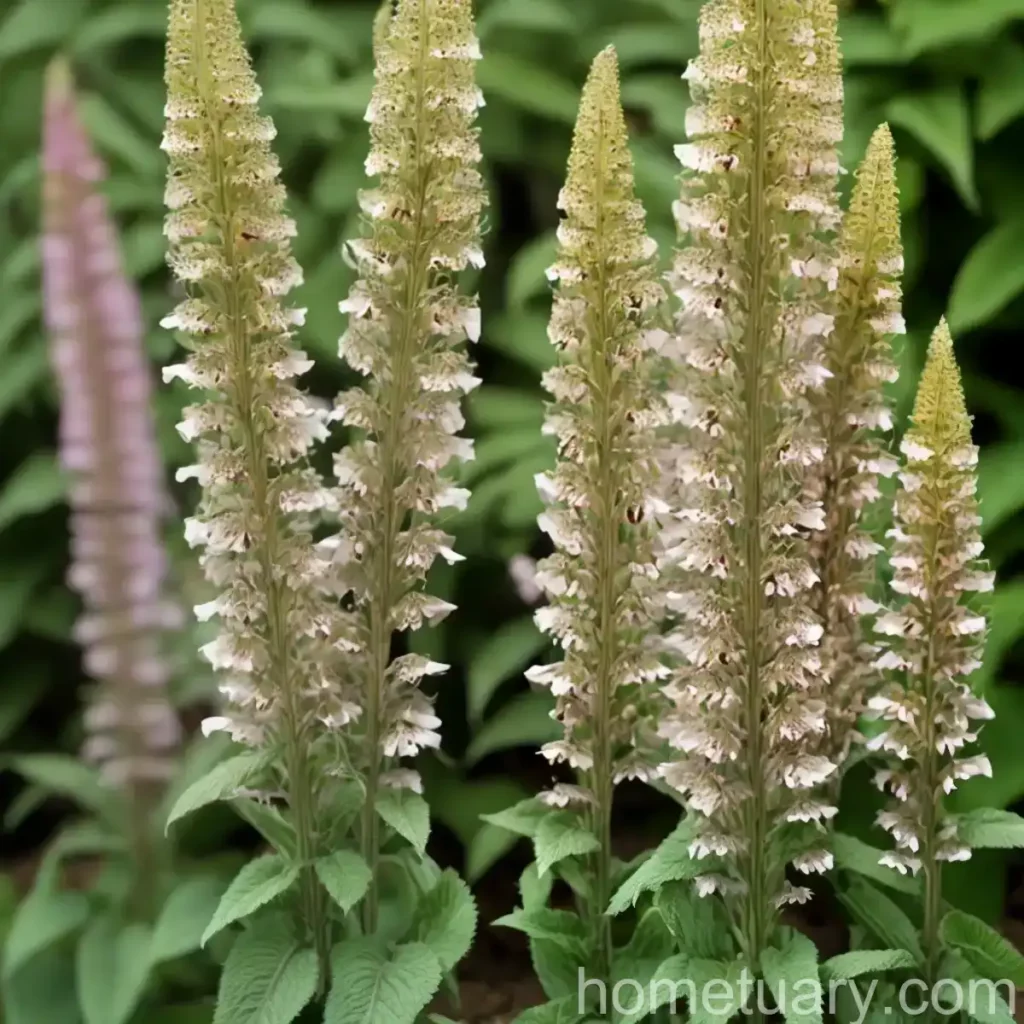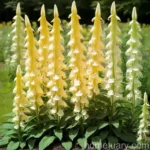Rusty Foxglove (Digitalis ferruginea ‘Gelber Herold’)
Digitalis ferruginea, commonly known as rusty foxglove, is an enchanting perennial plant that belongs to the family Plantaginaceae. It is esteemed for its erect spikes adorned with tubular, bell-shaped flowers that bloom in various shades of yellow, creating a stunning visual display in gardens and landscapes. Among its many cultivars, the ‘Gelber Herold’ variety is particularly renowned for its vibrant and captivating yellow blossoms.
In this comprehensive guide, we will delve into the various aspects of cultivating and caring for the rusty foxglove, with a specific focus on the ‘Gelber Herold’ variety. From understanding its cultural requirements and propagation techniques to discussing its uses in landscaping, we will explore all facets of growing and maintaining Digitalis ferruginea ‘Gelber Herold’. Whether you are a seasoned gardener or a novice enthusiast, this article aims to equip you with the knowledge and insights needed to cultivate and appreciate this exquisite plant.
Key Takeaways
Before we embark on our exploration of the rusty foxglove, let’s take a moment to highlight some key takeaways regarding Digitalis ferruginea ‘Gelber Herold’:
- Plant Name: Digitalis ferruginea ‘Gelber Herold’
- Common Name: Rusty foxglove
- Family: Plantaginaceae
- Variety: ‘Gelber Herold’
- Flower Color: Yellow
- Plant Type: Perennial
- Attracts: Pollinators
- Toxicity: Contains Digitalis glycosides
Now, let’s delve into the intricacies of caring for this captivating plant, covering various aspects such as culture, uses, maintenance, and more.
Culture
Cultivating Digitalis ferruginea ‘Gelber Herold’ requires an understanding of its specific cultural requirements to ensure its optimal growth and development. From suitable growing conditions to ideal maintenance practices, let’s explore the cultural aspects of caring for the rusty foxglove.
Uses
The rusty foxglove is valued for its ornamental qualities and finds various uses in gardening and landscaping. Whether utilized for its aesthetic appeal in garden beds and borders or employed for its medicinal properties, the uses of Digitalis ferruginea ‘Gelber Herold’ are diverse and compelling.
Ornamental Use
The striking yellow blossoms of the ‘Gelber Herold’ variety make it a sought-after choice for ornamental planting. Its tall, elegant flower spikes add vertical interest to gardens and create a captivating focal point when in bloom. Rusty foxglove can be incorporated into cottage gardens, woodland settings, or mixed perennial borders to introduce a touch of vibrancy and visual charm.
Medicinal Use
While it is crucial to highlight the toxic nature of Digitalis ferruginea due to its Digitalis glycoside content, certain cardiac medications have been derived from the compounds present in foxglove plants. However, it is of utmost importance to emphasize that any medicinal use or extraction of compounds from rusty foxglove should only be carried out by trained professionals due to the associated risks.
Water
Maintaining appropriate moisture levels is crucial for the health and vitality of rusty foxglove plants. While they are relatively tolerant of average watering, it is important to ensure that the soil does not become waterlogged, as excessive moisture can lead to root rot and other issues. Adequate drainage is essential, especially in regions prone to heavy rainfall, to prevent waterlogged conditions.
| Water Requirements for Digitalis ferruginea ‘Gelber Herold’ | Details |
|---|---|
| Optimal Watering Schedule | Allow the top inch of soil to dry out between waterings. |
| Signs of Overwatering | Yellowing or wilting of foliage, waterlogged soil, and a foul odor emanating from the root zone. |
| Signs of Underwatering | Drooping leaves, dry and parched soil, and wilting of the plant. |
| Special Considerations | Adjust watering frequency based on environmental conditions, such as temperature and humidity. |
| Watering Method | Water at the base of the plant to ensure that the soil around the roots is adequately moistened. |
Sunlight
Proper sunlight exposure is pivotal for the growth and flowering of Digitalis ferruginea ‘Gelber Herold’. Understanding its sunlight requirements and providing the ideal conditions for light exposure can significantly impact its overall health and blooming potential.
| Sunlight Requirements for Digitalis ferruginea ‘Gelber Herold’ | Details |
|---|---|
| Preferred Sun Exposure | Partial shade to full sun, with an emphasis on protection from intense afternoon sun in hotter climates. |
| Optimal Light Conditions | Filtered sunlight or dappled shade throughout the day, with a few hours of direct morning sun being beneficial. |
| Adaptation to Full Sun | In cooler regions, rusty foxglove can tolerate full sun, but in warmer areas, partial shade is recommended to prevent heat stress. |
Fertilizer
Fertilizing Digitalis ferruginea ‘Gelber Herold’ is integral to supporting its growth and enhancing its blooming performance. By providing the appropriate nutrients in the right quantities, gardeners can promote vigorous growth and vibrant flower production in rusty foxglove plants.
| Fertilization Practices for Digitalis ferruginea ‘Gelber Herold’ | Details |
|---|---|
| Fertilizer Type | Use a balanced, slow-release fertilizer or a diluted liquid fertilizer formulated for flowering perennials. |
| Application Timing | Apply fertilizer in early spring as new growth emerges, and consider a second application in midsummer to sustain blooming. |
| Avoidance of Over-Fertilization | Refrain from excessive fertilization, as it can lead to lush foliage growth at the expense of flower production. |
| Soil Amendment | Incorporate organic matter, such as compost, when planting to enrich the soil and provide a steady source of nutrients. |
Soil
The composition and quality of the soil profoundly influence the growth and vitality of rusty foxglove. Understanding its soil preferences and ensuring proper soil preparation are crucial steps in fostering healthy and flourishing plants.
| Soil Preferences for Digitalis ferruginea ‘Gelber Herold’ | Details |
|---|---|
| Preferred Soil Type | Well-draining, loamy soil with a slightly acidic to neutral pH range (pH 6.0–7.0). |
| Soil Moisture Level | Moderate to slightly moist soil conditions, avoiding waterlogged or excessively dry soils. |
| Soil Amendment | Incorporate organic matter, such as compost or well-rotted manure, into the soil to improve its structure and fertility. |
| Avoidance of Compacted Soil | Ensure that the soil is loose and friable to facilitate root development and efficient water penetration. |
Pruning
Pruning plays a significant role in maintaining the tidiness of rusty foxglove plants and shaping their growth. By implementing proper pruning techniques, gardeners can promote airflow, remove spent flower spikes, and manage the overall appearance of the plants.
| Pruning Techniques for Digitalis ferruginea ‘Gelber Herold’ | Details |
|---|---|
| Deadheading | Regularly remove spent flower spikes to encourage continuous blooming and prevent self-seeding in the garden. |
| Trimming Foliage | Trim back dead or yellowing foliage to maintain the plant’s vigor and aesthetics, particularly after the blooming season. |
| Pruning Height | Cut back the flower spikes to ground level once they have finished blooming to rejuvenate the plant and promote new growth. |
| Sterilization of Tools | Use clean, sharp pruners to prevent the spread of diseases, and disinfect the tools between cuts, especially if removing diseased growth. |
Propagation
The propagation of Digitalis ferruginea ‘Gelber Herold’ can be achieved through various methods, including seed propagation and division. By understanding the techniques and best practices for propagating this plant, gardeners can expand their collection and share its beauty with others.
| Propagation Methods for Digitalis ferruginea ‘Gelber Herold’ | Details |
|---|---|
| Seed Propagation | Collect seeds from mature flower spikes and sow them in a well-prepared seedbed or containers for germination. |
| Division | Divide established clumps in early spring, carefully separating the root mass and replanting the divisions in desired locations. |
| Propagation Medium | Use a well-draining, sterile growing medium for seed starting, and ensure that division segments have healthy root systems. |
| Optimal Germination Conditions | Provide consistent moisture, warmth, and bright, indirect light for successful seed germination and establishment. |
Container Popularity
The versatility of rusty foxglove extends to its potential for container gardening, where it can be showcased on patios, balconies, or in small urban spaces. Its striking vertical presence and vibrant blooms make it a popular choice for adding visual interest and color to container plantings.
| Container Gardening with Digitalis ferruginea ‘Gelber Herold’ | Details |
|---|---|
| Container Size | Select a spacious container with adequate depth to accommodate the root system and provide stability for the tall flower spikes. |
| Drainage Holes | Ensure that the container has sufficient drainage holes to prevent waterlogging and maintain healthy root conditions. |
| Growing Medium | Use a well-draining, quality potting mix with added perlite or coarse sand to enhance drainage and aeration for the roots. |
| Maintenance Considerations | Monitor moisture levels closely, especially during hot weather, and provide occasional fertilization to support container growth. |
Common Diseases
Like many plants, Digitalis ferruginea ‘Gelber Herold’ is susceptible to certain diseases, particularly those associated with fungal pathogens. Understanding the common diseases and their management is essential for maintaining the health and vigor of rusty foxglove plants.
Disease Diagnosis
- Powdery Mildew: Characterized by the development of a powdery, white substance on the leaves and stems, powdery mildew can affect the overall vigor and appearance of the plant. It is exacerbated by high humidity and poor air circulation.
- Leaf Spot: Irregularly shaped lesions with dark margins may appear on the foliage, often caused by various fungal pathogens. Leaf spot can lead to defoliation and reduced photosynthetic capacity.
- Root Rot: Excessive soil moisture can contribute to the development of root rot, leading to wilting, yellowing, and eventual collapse of the plant. Improving drainage and avoiding overwatering are crucial in preventing this disease.
Common Pests
Aphids, slugs, and snails are among the common pests that may target Digitalis ferruginea ‘Gelber Herold’. While not as prone to severe pest infestations as some other plants, rusty foxglove can still encounter pest-related challenges, particularly in humid and favorable conditions for pest activity.
Botanist’s Tips
Incorporating insights from experienced botanists and gardening professionals can provide valuable guidance for successfully cultivating Digitalis ferruginea ‘Gelber Herold’. Here are some expert tips to enhance your rusty foxglove gardening endeavors:
- Amend Soil Adequately: Prior to planting, ensure that the soil is well-draining and supplemented with organic matter to provide essential nutrients and a favorable growth environment for the plants.
- Support Tall Stems: As the flower spikes of rusty foxglove can reach considerable heights, consider providing discreet support structures to prevent bending or toppling of the stems, especially in windy conditions.
- Monitor Moisture Levels: Regularly assess the moisture content of the soil, particularly during periods of rainfall or drought, and adjust watering practices accordingly to maintain optimal soil conditions.
- Implement Integrated Pest Management: Be vigilant for pest activity and establish proactive pest management measures, such as handpicking caterpillars or deploying organic pest control solutions, to minimize damage to the plants.
Fun Facts
Uncover intriguing and delightful facts about Digitalis ferruginea ‘Gelber Herold’ that showcase its unique attributes and contributions in the realm of gardening and horticulture:
- Historical Significance: The genus name Digitalis is derived from the Latin word for “finger” and has been associated with medicinal and symbolic meanings throughout history.
- Pollinator Magnet: The tubular flowers of rusty foxglove attract a diverse array of pollinators, including bees, butterflies, and hummingbirds, contributing to biodiversity and ecological balance.
- Cultural Symbolism: Foxgloves have been featured in folklore and literature, often associated with enchantment and mystical qualities, adding to their allure and cultural significance.
- Architectural Elegance: The vertical stature and architectural form of the flower spikes make rusty foxglove a captivating addition to garden landscapes, offering a sense of drama and sophistication.
Links to External Resources
For further exploration and in-depth understanding of rusty foxglove and its cultivation, the following external resources provide valuable insights, recommendations, and reference materials:
- Royal Horticultural Society – Digitalis ferruginea
- University of Florida IFAS Extension – Digitalis Species
- Missouri Botanical Garden – Plant Finder: Digitalis ferruginea ‘Gelber Herold’
As we conclude this comprehensive guide to Digitalis ferruginea ‘Gelber Herold’, it is our hope that you have gained a profound understanding of the cultivation, care, and appreciation of the captivating rusty foxglove. By embracing its ornamental allure and harnessing its vitality in gardens, you can embark on a journey of horticultural delight and aesthetic enrichment with this remarkable perennial plant. May your gardening endeavors be adorned with the resplendent beauty of the ‘Gelber Herold’ variety, and may the enchanting presence of rusty foxglove enrich your outdoor spaces and inspire a deeper connection with the natural world.
Note: It is crucial to acknowledge the potential toxicity of Digitalis ferruginea ‘Gelber Herold’ due to the presence of Digitalis glycosides. Caution should be exercised, and any use for medicinal purposes should be strictly overseen by trained healthcare professionals.
In the pursuit of cultivating and caring for plants, may we find harmony and fulfillment in nurturing the botanical wonders that grace our lives.
Happy gardening!
By: Dr. Botanica Bloom
Published on: October 1, 2023
Plant Scientist | Horticultural Enthusiast















